sensor VOLVO S60 TWIN ENGINE 2019 Owners Manual
[x] Cancel search | Manufacturer: VOLVO, Model Year: 2019, Model line: S60 TWIN ENGINE, Model: VOLVO S60 TWIN ENGINE 2019Pages: 645, PDF Size: 13.96 MB
Page 4 of 645

2
OWNER'S INFORMATION
Owner's information16
Owner's Manual in the center display17
Navigate in the Owner's Manual inthe center display18
Owner's manual in mobile devices20
Volvo Cars support site21
Using the Owner's Manual21
The Owner's Manual and the envi-ronment23
YOUR VOLVO
Contacting Volvo26
Volvo ID26
Creating and registering a Volvo ID27
Drive-E ‒ purer driving pleasure27
IntelliSafe – driver support and safety28
Sensus - connection and entertainment30
Software Updates33
Data recording33
Terms & Conditions for Services35
Customer Privacy Policy35
Important information on accessoriesand extra equipment35
Accessory installation36
Connecting equipment to the vehi-cle's data link connector37
Technician certification38
Viewing the Vehicle IdentificationNumber (VIN)38
Volvo Structural Parts Statement39
Driver distraction39
SAFETY
Safety42
Safety during pregnancy43
Occupant safety43
Reporting safety defects44
Recall information45
Whiplash Protection System46
Seat belts47
Buckling and unbuckling seat belts48
Seat belt tensioners50
Resetting the electric seat belt ten-sioners*51
Door and seat belt reminders51
Airbags52
Driver/passenger-side airbags53
Occupant weight sensor56
Side airbags60
Inflatable curtain60
Safety mode61
Starting and moving the vehiclewhen it is in safety mode62
Child safety63
Child restraints65
Infant seats67
Convertible seats69
Booster cushions71
TABLE OF CONTENTS
Page 5 of 645
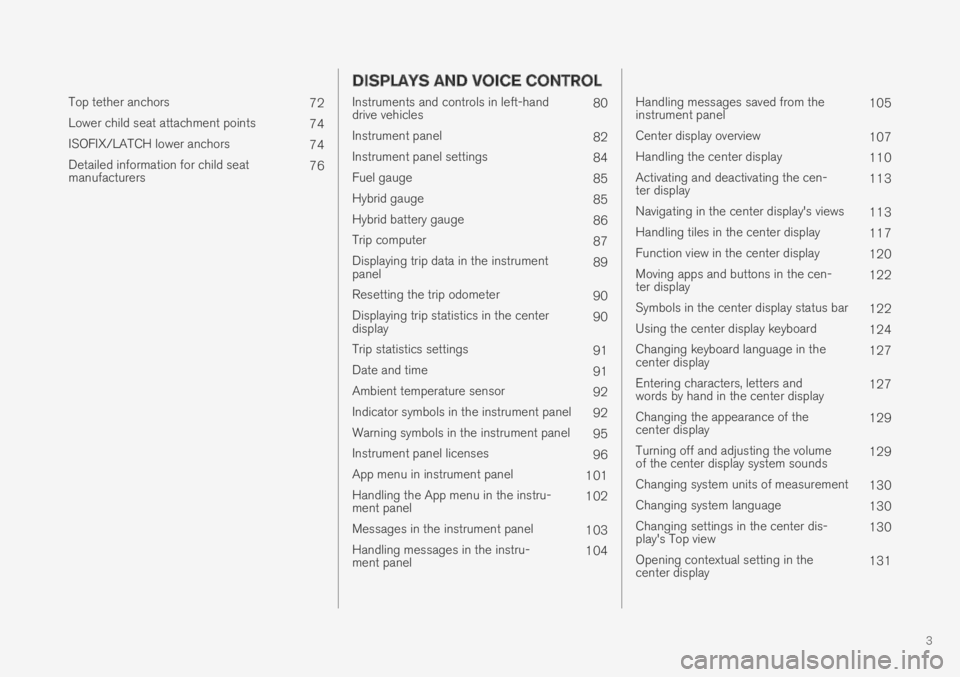
3
Top tether anchors72
Lower child seat attachment points74
ISOFIX/LATCH lower anchors74
Detailed information for child seatmanufacturers76
DISPLAYS AND VOICE CONTROL
Instruments and controls in left-handdrive vehicles80
Instrument panel82
Instrument panel settings84
Fuel gauge85
Hybrid gauge85
Hybrid battery gauge86
Trip computer87
Displaying trip data in the instrumentpanel89
Resetting the trip odometer90
Displaying trip statistics in the centerdisplay90
Trip statistics settings91
Date and time91
Ambient temperature sensor92
Indicator symbols in the instrument panel92
Warning symbols in the instrument panel95
Instrument panel licenses96
App menu in instrument panel101
Handling the App menu in the instru-ment panel102
Messages in the instrument panel103
Handling messages in the instru-ment panel104
Handling messages saved from theinstrument panel105
Center display overview107
Handling the center display110
Activating and deactivating the cen-ter display113
Navigating in the center display's views113
Handling tiles in the center display117
Function view in the center display120
Moving apps and buttons in the cen-ter display122
Symbols in the center display status bar122
Using the center display keyboard124
Changing keyboard language in thecenter display127
Entering characters, letters andwords by hand in the center display127
Changing the appearance of thecenter display129
Turning off and adjusting the volumeof the center display system sounds129
Changing system units of measurement130
Changing system language130
Changing settings in the center dis-play's Top view130
Opening contextual setting in thecenter display131
Page 6 of 645
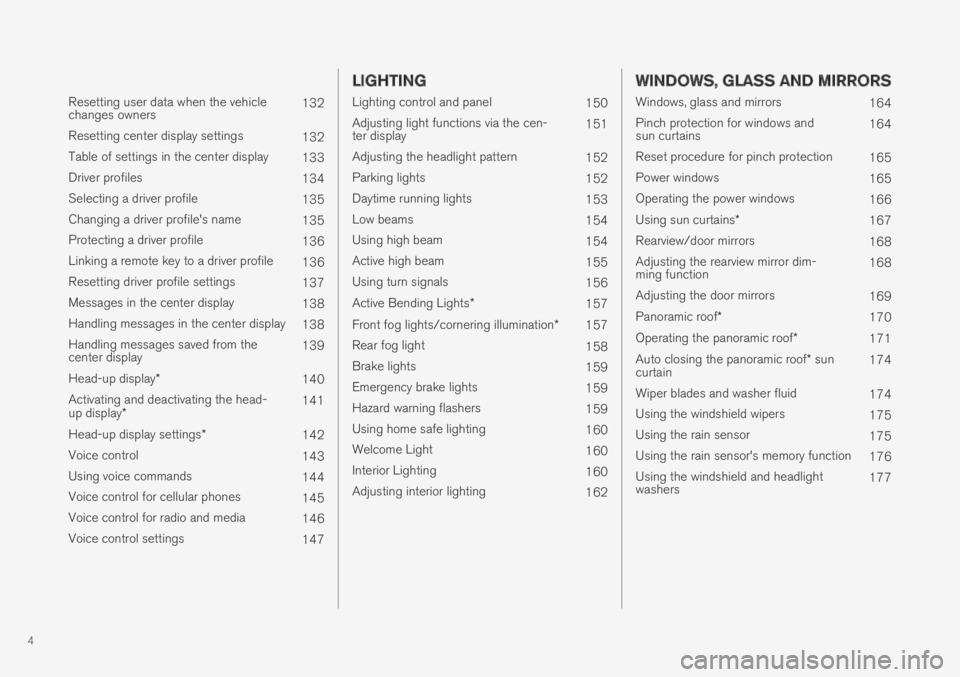
4
Resetting user data when the vehiclechanges owners132
Resetting center display settings132
Table of settings in the center display133
Driver profiles134
Selecting a driver profile135
Changing a driver profile's name135
Protecting a driver profile136
Linking a remote key to a driver profile136
Resetting driver profile settings137
Messages in the center display138
Handling messages in the center display138
Handling messages saved from thecenter display139
Head-up display*140
Activating and deactivating the head-up display*141
Head-up display settings*142
Voice control143
Using voice commands144
Voice control for cellular phones145
Voice control for radio and media146
Voice control settings147
LIGHTING
Lighting control and panel150
Adjusting light functions via the cen-ter display151
Adjusting the headlight pattern152
Parking lights152
Daytime running lights153
Low beams154
Using high beam154
Active high beam155
Using turn signals156
Active Bending Lights*157
Front fog lights/cornering illumination*157
Rear fog light158
Brake lights159
Emergency brake lights159
Hazard warning flashers159
Using home safe lighting160
Welcome Light160
Interior Lighting160
Adjusting interior lighting162
WINDOWS, GLASS AND MIRRORS
Windows, glass and mirrors164
Pinch protection for windows andsun curtains164
Reset procedure for pinch protection165
Power windows165
Operating the power windows166
Using sun curtains*167
Rearview/door mirrors168
Adjusting the rearview mirror dim-ming function168
Adjusting the door mirrors169
Panoramic roof*170
Operating the panoramic roof*171
Auto closing the panoramic roof* suncurtain174
Wiper blades and washer fluid174
Using the windshield wipers175
Using the rain sensor175
Using the rain sensor's memory function176
Using the windshield and headlightwashers177
Page 7 of 645

5
SEATS AND STEERING WHEEL
Manual front seats180
Power* front seats181
Adjusting the power* front seats181
Storing positions for seats, mirrorsand head-up display*182
Using stored positions for seats, mir-rors and head-up display*183
Front seat massage* settings184
Adjusting front seat massage settings*185
Adjusting* front seat cushion length185
Adjusting front seat side bolster settings*186
Adjusting front seat lumbar support*187
Adjusting the passenger seat fromthe driver's seat*188
Folding down the rear seat backrests*189
Adjusting the rear seat head restraints191
Steering wheel controls and horn192
Adjusting the steering wheel193
CLIMATE CONTROL
Climate196
Climate zones196
Climate control sensors196
Perceived temperature197
Climate control system voice commands197
Air quality198
Clean Zone*199
Clean Zone Interior Package*199
Interior Air Quality System*200
Activating and deactivating the airquality sensor*200
Passenger compartment air filter201
Air distribution201
Adjusting air distribution202
Opening, closing and directing air vents202
Air distribution options204
Climate system controls207
Activating and deactivating powerfront seats*208
Activating and deactivating theheated front seat*209
Activating and deactivating theheated rear seats*209
Activating and deactivating front seatventilation*209
Activating and deactivating theheated steering wheel*210
Activating and deactivating automaticsteering wheel heating*210
Activating auto climate control211
Activating and deactivating recirculation211
Activating and deactivating the recir-culation timer setting212
Activating and deactivating max defroster212
Activating and deactivating theheated rear window and door mirrors213
Automatically activating and deacti-vating the heated rear window anddoor mirrors
214
Setting the blower speed for thefront seats214
Setting the temperature for the frontseats215
Synchronize temperature216
Activating and deactivating air condi-tioning216
Parking climate217
Preconditioning217
Starting and stopping preconditioning218
Preconditioning timer219
Adding and editing timer settings forpreconditioning219
Page 9 of 645

7
DRIVER SUPPORT
Driver support systems260
Speed-dependent steering wheelresistance260
Electronic Stability Control261
Electronic Stability Control in sport mode262
Activating/deactivating Sport modefor Electronic Stability Control263
Electronic Stability Control symbolsand messages264
Cruise control266
Activating and starting Cruise Control267
Deactivating and putting Cruise Con-trol in standby mode268
Reactivating Cruise Control fromstandby mode269
Switching off Cruise Control269
Distance Alert*270
Activating/deactivating Distance Alert271
Distance Alert limitations271
Adaptive Cruise Control*272
Adaptive Cruise Control* controlsand displays273
Activating and starting AdaptiveCruise Control*274
Deactivating/reactivating AdaptiveCruise Control*275
Adaptive Cruise Control* limitations277
Switching between Cruise Controland Adaptive Cruise Control*277
Symbols and messages for AdaptiveCruise Control*279
Pilot Assist281
Pilot Assist controls and display283
Activating and starting Pilot Assist284
Deactivating/reactivating Pilot Assist285
Pilot Assist limitations287
Pilot Assist* symbols and messages288
Collision risk warning from driver support290
Switching target vehicles with driversupport291
Set time interval for driver support292
Drive mode for driver support293
Adjusting set speed for driver support293
Auto-hold braking with driver support294
Passing assistance295
Using passing assistance296
Radar sensor297
Radar sensor type approval297
Camera299
Camera/radar sensor limitations300
Recommended camera and radarsensor maintenance304
City Safety™305
City Safety parameters and sub-functions306
Setting a warning distance for City Safety308
Detecting obstacles with City Safety309
City Safety in crossing traffic311
Limitations of City Safety in crossingtraffic312
City Safety steering assistance forevasive maneuver313
City Safety steering assistance limi-tations during evasive maneuvers314
City Safety and delayed evasivemaneuvers314
City Safety braking for oncoming vehicles315
City Safety limitations316
City Safety messages319
Rear Collision Warning320
Rear Collision Warning limitations320
BLIS*321
Activating or deactivating BLIS322
BLIS limitations323
BLIS messages324
Cross Traffic Alert*325
Activating/deactivating Cross TrafficAlert326
Cross Traffic Alert limitations326
Cross Traffic Alert messages328
Page 10 of 645
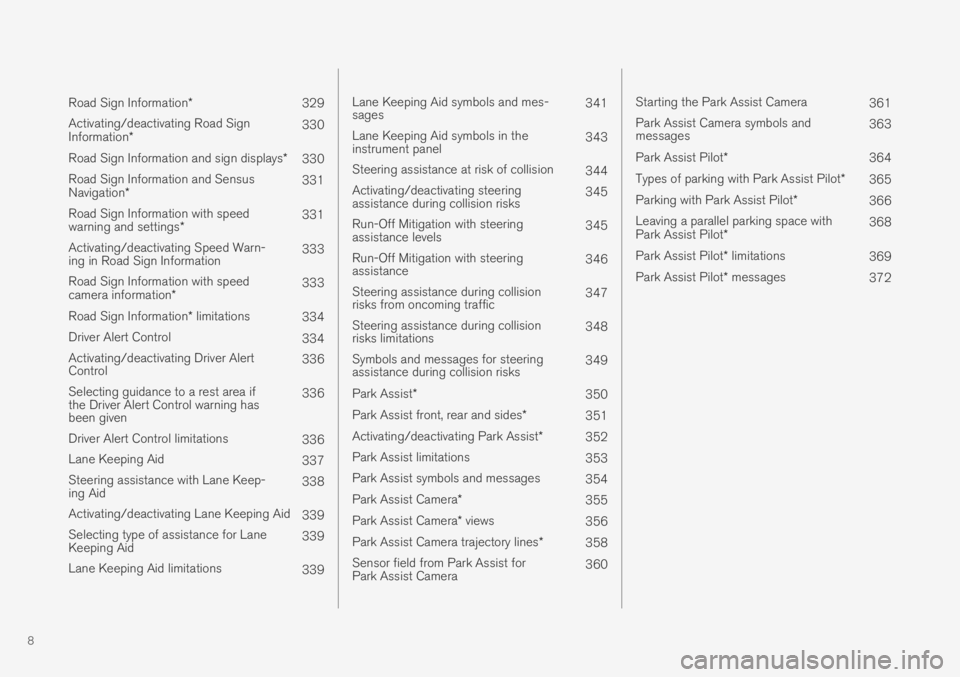
8
Road Sign Information*329
Activating/deactivating Road SignInformation*330
Road Sign Information and sign displays*330
Road Sign Information and SensusNavigation*331
Road Sign Information with speedwarning and settings*331
Activating/deactivating Speed Warn-ing in Road Sign Information333
Road Sign Information with speedcamera information*333
Road Sign Information* limitations334
Driver Alert Control334
Activating/deactivating Driver AlertControl336
Selecting guidance to a rest area ifthe Driver Alert Control warning hasbeen given
336
Driver Alert Control limitations336
Lane Keeping Aid337
Steering assistance with Lane Keep-ing Aid338
Activating/deactivating Lane Keeping Aid339
Selecting type of assistance for LaneKeeping Aid339
Lane Keeping Aid limitations339
Lane Keeping Aid symbols and mes-sages341
Lane Keeping Aid symbols in theinstrument panel343
Steering assistance at risk of collision344
Activating/deactivating steeringassistance during collision risks345
Run-Off Mitigation with steeringassistance levels345
Run-Off Mitigation with steeringassistance346
Steering assistance during collisionrisks from oncoming traffic347
Steering assistance during collisionrisks limitations348
Symbols and messages for steeringassistance during collision risks349
Park Assist*350
Park Assist front, rear and sides*351
Activating/deactivating Park Assist*352
Park Assist limitations353
Park Assist symbols and messages354
Park Assist Camera*355
Park Assist Camera* views356
Park Assist Camera trajectory lines*358
Sensor field from Park Assist forPark Assist Camera360
Starting the Park Assist Camera361
Park Assist Camera symbols andmessages363
Park Assist Pilot* 364
Types of parking with Park Assist Pilot*365
Parking with Park Assist Pilot*366
Leaving a parallel parking space withPark Assist Pilot*368
Park Assist Pilot* limitations 369
Park Assist Pilot* messages372
Page 41 of 645
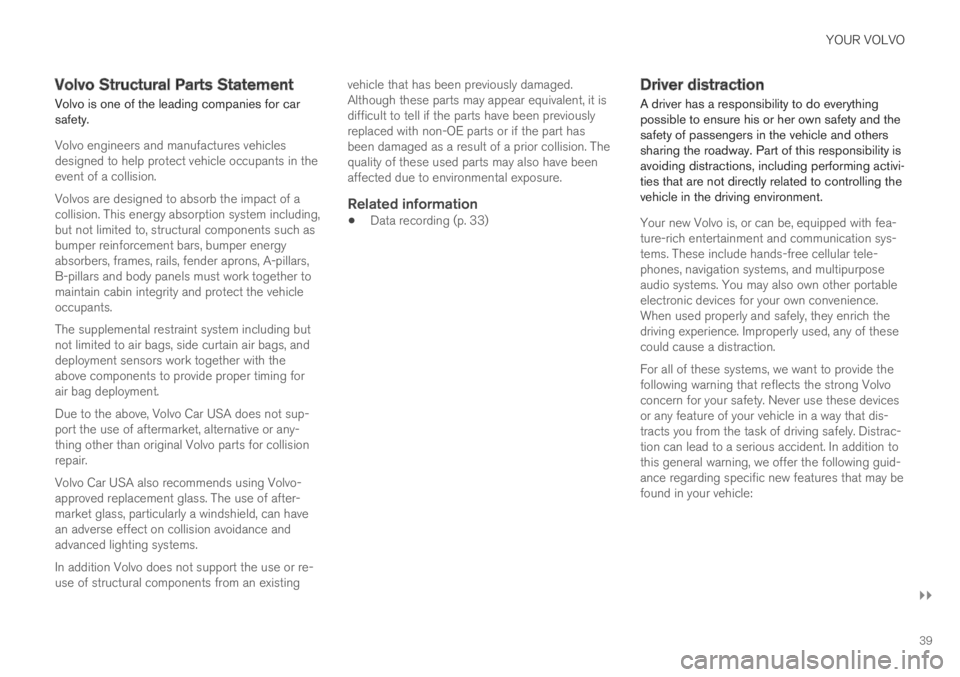
YOUR VOLVO
}}
39
Volvo Structural Parts Statement
Volvo is one of the leading companies for carsafety.
Volvo engineers and manufactures vehiclesdesigned to help protect vehicle occupants in theevent of a collision.
Volvos are designed to absorb the impact of acollision. This energy absorption system including,but not limited to, structural components such asbumper reinforcement bars, bumper energyabsorbers, frames, rails, fender aprons, A-pillars,B-pillars and body panels must work together tomaintain cabin integrity and protect the vehicleoccupants.
The supplemental restraint system including butnot limited to air bags, side curtain air bags, anddeployment sensors work together with theabove components to provide proper timing forair bag deployment.
Due to the above, Volvo Car USA does not sup-port the use of aftermarket, alternative or any-thing other than original Volvo parts for collisionrepair.
Volvo Car USA also recommends using Volvo-approved replacement glass. The use of after-market glass, particularly a windshield, can havean adverse effect on collision avoidance andadvanced lighting systems.
In addition Volvo does not support the use or re-use of structural components from an existing
vehicle that has been previously damaged.Although these parts may appear equivalent, it isdifficult to tell if the parts have been previouslyreplaced with non-OE parts or if the part hasbeen damaged as a result of a prior collision. Thequality of these used parts may also have beenaffected due to environmental exposure.
Related information
Data recording (p. 33)
Driver distraction
A driver has a responsibility to do everythingpossible to ensure his or her own safety and thesafety of passengers in the vehicle and otherssharing the roadway. Part of this responsibility isavoiding distractions, including performing activi-ties that are not directly related to controlling thevehicle in the driving environment.
Your new Volvo is, or can be, equipped with fea-ture-rich entertainment and communication sys-tems. These include hands-free cellular tele-phones, navigation systems, and multipurposeaudio systems. You may also own other portableelectronic devices for your own convenience.When used properly and safely, they enrich thedriving experience. Improperly used, any of thesecould cause a distraction.
For all of these systems, we want to provide thefollowing warning that reflects the strong Volvoconcern for your safety. Never use these devicesor any feature of your vehicle in a way that dis-tracts you from the task of driving safely. Distrac-tion can lead to a serious accident. In addition tothis general warning, we offer the following guid-ance regarding specific new features that may befound in your vehicle:
Page 44 of 645
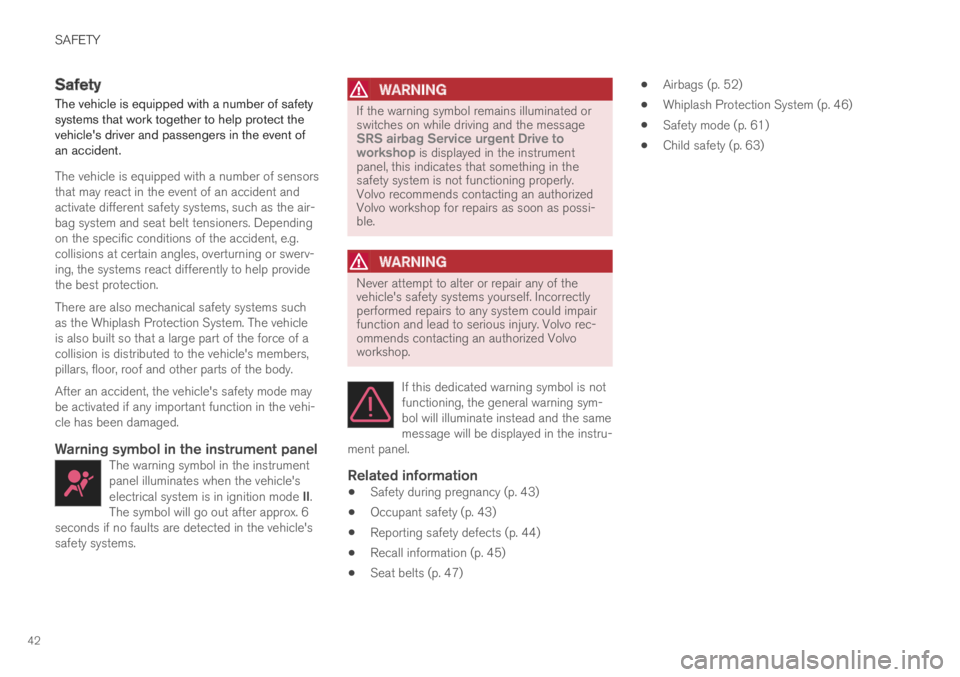
SAFETY
42
Safety
The vehicle is equipped with a number of safetysystems that work together to help protect thevehicle's driver and passengers in the event ofan accident.
The vehicle is equipped with a number of sensorsthat may react in the event of an accident andactivate different safety systems, such as the air-bag system and seat belt tensioners. Dependingon the specific conditions of the accident, e.g.collisions at certain angles, overturning or swerv-ing, the systems react differently to help providethe best protection.
There are also mechanical safety systems suchas the Whiplash Protection System. The vehicleis also built so that a large part of the force of acollision is distributed to the vehicle's members,pillars, floor, roof and other parts of the body.
After an accident, the vehicle's safety mode maybe activated if any important function in the vehi-cle has been damaged.
Warning symbol in the instrument panel
The warning symbol in the instrumentpanel illuminates when the vehicle'selectrical system is in ignition mode II.The symbol will go out after approx. 6seconds if no faults are detected in the vehicle'ssafety systems.
WARNING
If the warning symbol remains illuminated orswitches on while driving and the messageSRS airbag Service urgent Drive toworkshop is displayed in the instrumentpanel, this indicates that something in thesafety system is not functioning properly.Volvo recommends contacting an authorizedVolvo workshop for repairs as soon as possi-ble.
WARNING
Never attempt to alter or repair any of thevehicle's safety systems yourself. Incorrectlyperformed repairs to any system could impairfunction and lead to serious injury. Volvo rec-ommends contacting an authorized Volvoworkshop.
If this dedicated warning symbol is notfunctioning, the general warning sym-bol will illuminate instead and the samemessage will be displayed in the instru-ment panel.
Related information
Safety during pregnancy (p. 43)
Occupant safety (p. 43)
Reporting safety defects (p. 44)
Recall information (p. 45)
Seat belts (p. 47)
Airbags (p. 52)
Whiplash Protection System (p. 46)
Safety mode (p. 61)
Child safety (p. 63)
Page 55 of 645

SAFETY
}}
53
WARNING
If your vehicle has become water-damaged inany way (e.g., soaked floor mats/standingwater on the floor of the vehicle), do notattempt to start the engine. This may causeairbag deployment, which could result in seri-ous injury. Volvo recommends towing thevehicle directly to an authorized Volvo work-shop.
Before attempting to tow the vehicle:
1.Switch off the ignition for at least 10minutes and disconnect the battery.
2. Follow the instructions for manually over-riding the shiftlock system.
Deployed airbags
WARNING
If any of the airbags have deployed:
Do not attempt to drive the vehicle. Haveit towed to an authorized workshop.
If necessary, seek medical attention.
Related information
Safety (p. 42)
Driver/passenger-side airbags (p. 53)
Side airbags (p. 60)
Inflatable curtain (p. 60)
Driver/passenger-side airbags
As a supplement to the seat belts, the vehicle isequipped with driver and passenger side frontairbags.
Driver/passenger side front airbags.
In a frontal collision, the airbags help protect thedriver's and passenger's head, neck, face andchest and the driver's knees and legs.
A collision of a sufficiently violent force will trig-ger the sensors and one or more airbags willinflate. The airbag helps cushion the initial impactof the collision for the passenger. The airbagdeflates when compressed by the collision. Asmall amount of powder will also be releasedfrom the airbag. This may appear to be smokeand is normal. The entire process, from inflationto deflation of the airbag, occurs within tenths ofa second.
NOTE
The sensors react differently depending onthe circumstances of the accident andwhether or not the seat belt is used. Thisapplies to all belt positions.
There may therefore be accident situations inwhich only one (or none) of the airbags aredeployed. The sensors monitor the impact ofthe collision and react accordingly to deployone, several or no airbags.
WARNING
The seat belt and the airbag work together. Ifthe seat belt is not used or is used incorrectly,the airbag may not provide the intended pro-tection in a collision.
To help prevent injury in the event the airbagis deployed, passengers should sit as uprightas possible, with their feet on the floor andtheir backs against the seat backrest.
WARNING
Volvo recommends contacting an authorizedVolvo workshop for repairs. Incorrectly per-formed repairs to the airbag system couldimpair function and lead to serious injury.
The front airbag system
The front airbag system includes gas generatorssurrounded by the airbags, and deceleration sen-
Page 56 of 645

||
SAFETY
54
sors that activate the gas generators, causing theairbags to be inflated with nitrogen gas.
As the movement of the seats' occupants com-presses the airbags, some of the gas is expelledat a controlled rate to provide better cushioning.The belt tensioners minimize slack in the seatbelts and are activated for occupants wearingtheir seat belts. The entire process, from inflationto deflation of the airbag, occurs within tenths ofa second.
The location of the front airbags is indicated bySRS AIRBAG embossed on the steering wheelpad and above the glove compartment, and bydecals on both sun visors and on the front andfar right side of the dash.
The driver's side front airbag is folded andlocated in the steering wheel hub.
The knee airbag is folded on the underside ofthe dashboard on the driver's side. The textAIRBAG is embossed on the panel.
The passenger's side front airbag is foldedbehind a panel located above the glove compart-ment.
WARNING
The airbags in the vehicle are designed tobe a SUPPLEMENT to-not a replacementfor-the three-point seat belts. For maxi-mum protection, wear seat belts at alltimes. Be aware that no system can pre-vent all possible injuries that may occur inan accident.
Never drive with your hands on the steer-ing wheel pad/airbag housing.
The front airbags are designed to helpprevent serious injury. Deployment occursvery quickly and with considerable force.During normal deployment and depend-ing on variables such as seating position,one may experience abrasions, bruises,swellings, or other injuries as a result ofdeployment of one or both of the airbags.
When installing any accessory equipment,make sure that the front airbag system isnot damaged. Any interference in the sys-tem could cause malfunction.
Front airbag deployment
The front airbags are designed to deploy dur-ing certain frontal or front-angular collisions,impacts, or decelerations, depending on thecrash severity, angle, speed and objectimpacted. The airbags may also deploy in
certain non-frontal collisions where rapiddeceleration occurs.
The airbag system's sensors, which triggerthe front airbags, are designed to determineif the collision is powerful enough to activatethe belt tensioners and/or the airbags.
However, not all frontal collisions activate thefront airbags.
If the collision involves a nonrigid object (e.g.,a snow drift or bush), or a rigid, fixed objectat a low speed, the front airbags will not nec-essarily deploy.
Front airbags do not normally deploy in aside impact collision, in a collision from therear or in a rollover situation.
The amount of damage to the bodyworkdoes not reliably indicate if the airbagsshould have deployed or not.